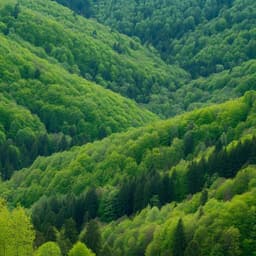
Environmental Studies and Forestry
The 2018 European heatwave led to stem dehydration but not to consistent growth reductions in forests
R. L. Salomón, R. L. Peters, et al.
Discover how the 2018 European heatwave affected tree growth and water status across 21 species in a comprehensive study led by an accomplished team of researchers. Findings reveal surprising differences in resilience to stress between conifers and broadleaves, shedding light on the complex responses of forest ecosystems to extreme weather events.
~3 min • Beginner • English
Introduction
The study addresses how extreme heatwaves, which are increasing in frequency and intensity in Europe, affect tree-level physiology across large spatial scales. Heatwaves often co-occur with drought, compounding stress on forests and potentially reducing productivity, vigor, and survival through mechanisms such as stomatal closure, carbon uptake limitation, stem water depletion, and hydraulic failure. The 2018 European heatwave (HW2018) provided a natural experiment to assess impacts on tree growth (GRO) and tree water status (tree water deficit, TWD) using high-temporal resolution dendrometer data. The authors hypothesized: (1) relative to previous years, HW2018 would limit annual stem growth and increase TWD, with magnitude depending on local environmental conditions; and (2) conifers would show lower TWD (i.e., better maintenance of stem water reserves) than broadleaves due to more conservative water-use strategies. The purpose was to provide mechanistic, tree-level insight across species and sites, filling a gap left by ecosystem and satellite-based assessments.
Literature Review
Methodology
Data and sites: High-resolution point and band dendrometer measurements (15–60 min resolution) were compiled from 85 monitoring plots across Europe and clustered into 53 sites based on proximity (≤9 km), elevation (<300 m difference), and soil water similarity. The final dataset comprised 377 trees of 21 species monitored over 2016–2018, with detailed quality assessment to flag plateauing band data (>7 days) and gaps (>14 days). Species, coordinates, radius time series (µm), timestamps (with time zone), and climate metadata were compiled.
Climate data: Site-specific daily mean air temperature and vapour pressure deficit (VPD) were obtained from nearby GSOD stations (≤80 km), gap-filled by interpolation when correlated with in situ data (r > 0.7). Soil moisture (28–100 cm) was extracted from ERA5-Land and scaled to Relative Extractable Water (REW) using REW = (SM − SMmin)/(SM95th − SMmin) to normalize across sites. Long-term climatology was taken from CHELSA. Heatwave days were defined via E-OBS as ≥5 consecutive days with Tmax > 90th percentile of 1951–2000; a common HW2018 timeframe across sites was set to DOY 208–264.
Signal processing: Dendrometer series were cleaned and homogenized using tree-netproc (R). The zero-growth concept partitioned irreversible growth (GRO) and reversible stem fluctuations due to water status (TWD). Growth occurs when a new maximum radius is exceeded; deviations below prior maxima indicate TWD (stem dehydration). Daily cumulative GRO and daily minimum and maximum TWD were derived.
Analysis approach 1 (annual scale): For each tree and year (2016–2018), cumulative annual GRO and mean daily min/max TWD over HW timeframe were computed. Tree-specific response ratios were calculated for 2018 relative to the control years (2016–2017): GRO2018:control and TWD2018:control, log10-transformed (adding 1 µm to GRO to retain zeros). Linear mixed-effects models (LMMs; lme4) tested differences in GRO and TWD ratios and between taxonomic clades (broadleaf vs conifer), with species and site as crossed random effects; significance via lmerTest. Correlation between log10(GRO2018:control) and log10(min TWD2018:control) was assessed similarly. Estimates were back-transformed for reporting.
Analysis approach 2 (daily, hydrometeorological space): For daily analyses, the ratio of 2018 daily TWD to the 95th percentile of control years (2016–2017) within the HW timeframe was computed to benchmark against near-maximum control shrinkage. LMMs predicted daily min and max TWD2018:control as functions of absolute daily VPD2018 (quadratic) and REW2018 (cubic), with tree nested within site and species as crossed random intercepts. A common hydrometeorological space (overlapping VPD–REW ranges) for broadleaves and conifers was defined for comparison. Species-specific models were also fit for Fagus sylvatica, Quercus spp. (Q. robur/petraea), Picea abies, and Pinus sylvestris using relaxed inclusion criteria to maximize coverage. Model outputs were back-transformed to quantify the proportion of hydrometeorological space in categories of TWD2018:control. All analyses used R 3.6.3.
Data and code: Datasets are available via Zenodo; analysis scripts available from corresponding authors upon request.
Key Findings
- Stem water status: Across the heatwave timeframe, daily minimum TWD in 2018 nearly doubled relative to control years (back-transformed min TWD2018:control = 1.8, SE = 1.1, P < 0.001). Daily maximum TWD was also higher (max TWD2018:control = 1.6, SE = 1.1, P < 0.001). No significant differences between broadleaves and conifers at the annual summary level for min or max TWD.
- Growth: Annual stem growth did not show a consistent reduction in 2018 relative to controls (GRO2018:control = 0.9, SE = 1.1, P = 0.1) and did not differ significantly between clades (P = 0.1). At sites with higher VPD and lower REW in 2018 than 2017, there was a non-significant trend toward lower growth in 2018 (P = 0.06). Min TWD2018:control and GRO2018:control were inversely related across species (P = 0.03).
- Hydrometeorological space responses: Both daily min and max TWD2018:control increased with decreasing REW and increasing VPD for broadleaves and conifers (P < 0.05). The fraction of the shared VPD–REW space where daily min TWD2018:control > 1 (i.e., larger shrinkage than the 95th percentile of control) was about twice as large for conifers (23%) as for broadleaves (10%). Daily max TWD2018:control distributions were similar between clades. Consequently, the sub-daily TWD amplitude (max−min) was larger in broadleaves, indicating better overnight stem rehydration than conifers under comparable conditions.
- Species-specific patterns: Quercus spp. showed the lowest min TWD2018:control over most of their hydrometeorological space (74% with values < 0.5), with very high values (>2) restricted to extremely dry soils (REW < 0.1). Conifers (Picea abies, Pinus sylvestris) exhibited moderate to high min TWD2018:control across most of their space (74–77% > 0.5), increasing with atmospheric and soil drought. Fagus sylvatica was intermediate.
- Overall: HW2018 led to widespread, transient stem dehydration but not to consistent annual growth reductions across sites and species; conifers were less capable of overnight rehydration than broadleaves; Norway spruce and Scots pine were particularly affected by extensive stem dehydration.
Discussion
The absence of a consistent reduction in 2018 annual stem growth likely reflects the timing of HW2018. The heatwave began in late July at most sites, when cell division and enlargement (the phases contributing to detectable stem-girth increment) were nearing cessation; thus much of the year's volumetric growth had already occurred. Ecosystem-level observations corroborate this pattern: a warm, humid spring enhanced carbon uptake, while the summer drought rapidly weakened the sink strength, yielding near-average annual ecosystem carbon uptake after compensation between seasons. In contrast, the clear increase in TWD indicates enhanced stem dehydration across broadleaf and conifer species during the heatwave, likely amplified by increased spring leaf area and transpiration. Elevated TWD suggests reduced capacity to buffer transpiration with internal water stores and potential hydraulic conductivity losses, aligning with remote-sensing evidence of reduced greenness and leaf area, early senescence, and partial canopy dieback in 2018.
Across the VPD–REW space, conifers showed larger daily minimum TWD2018:control and lower sub-daily TWD amplitude than broadleaves, indicating poorer overnight refilling and greater relative dehydration under similar conditions. This pattern may relate to lower xylem-specific hydraulic conductivity, lower minimum leaf conductance at high VPD, and greater propensity to hydraulically disconnect from the atmosphere and/or soil. Broadleaves, which tend to operate closer to hydraulic thresholds, maintained the soil–plant–atmosphere continuum more often, enabling nocturnal replenishment and transpirational cooling, albeit at the cost of increased short-term risk and potential leaf shedding under extreme stress. Species differences were marked: oaks remained relatively hydrated across most conditions (deep rooting and physiological plasticity likely contributors), while Norway spruce and Scots pine showed widespread dehydration vulnerability, consistent with reported drought legacy effects in Pinaceae and projected distribution shifts. The inverse association between TWD and growth hints that acute dehydration may abbreviate growth phases. Persistent dehydration may presage longer-term growth declines and tree decline, supporting the use of dendrometer-derived TWD signals as early warnings of stress thresholds and potential productivity losses.
Conclusion
This study demonstrates that the 2018 European heatwave broadly increased stem dehydration but did not uniformly suppress annual stem growth across diverse European forests, largely due to event timing relative to growth phenology. Conifers, especially Picea abies and Pinus sylvestris, were less capable of nightly rehydration and experienced greater relative stem dehydration than broadleaves under comparable atmospheric and soil drought, whereas Quercus spp. maintained comparatively better hydration. High-frequency dendrometer networks provide mechanistic, tree-level insights at large spatial scales and can serve as early warning systems for stress-induced declines. Future research should expand and harmonize dendrometer datasets, integrate tree-level hydraulics and transpiration data with ecosystem flux and remote sensing products, and link dendrometer signals to species-specific hydraulic and root traits to improve prediction of drought impacts, legacy effects, and mortality risk.
Limitations
- Spatial and taxonomic coverage: The network predominantly covered Central and Atlantic Europe; conifer data were largely limited to Pinaceae, potentially limiting generalization to other conifer families (e.g., Cupressaceae).
- Data harmonization and sensor issues: Diverse dendrometer types required homogenization; band dendrometers can plateau, and time series gaps existed despite quality control.
- Control period choices and model constraints: Annual analyses used only 2016–2017 as controls to minimize structural changes; daily analyses benchmarked to the 95th percentile of controls. Species-specific models sometimes required relaxed inclusion criteria due to limited spatial coverage, and initial models faced convergence issues. The overlap in common hydrometeorological space between clades/species was limited in some comparisons.
- Timing specificity: Findings on growth impacts are contingent on the late-summer timing of HW2018 and may not extrapolate to events occurring earlier in the growing season.
Related Publications
Explore these studies to deepen your understanding of the subject.







